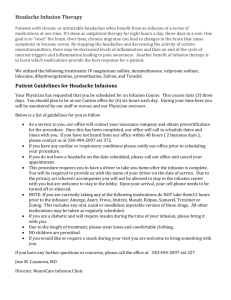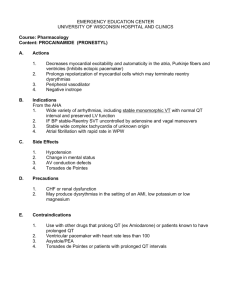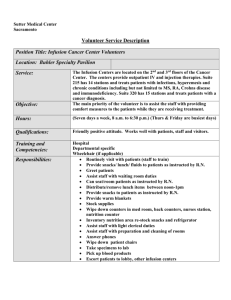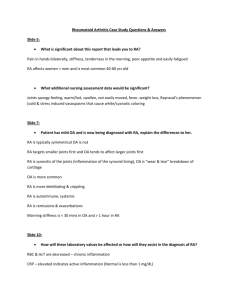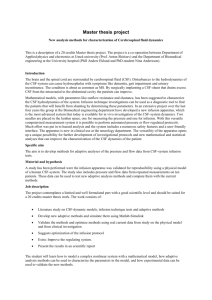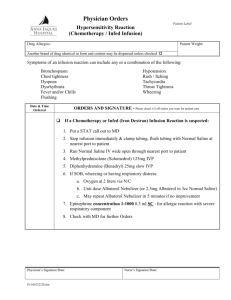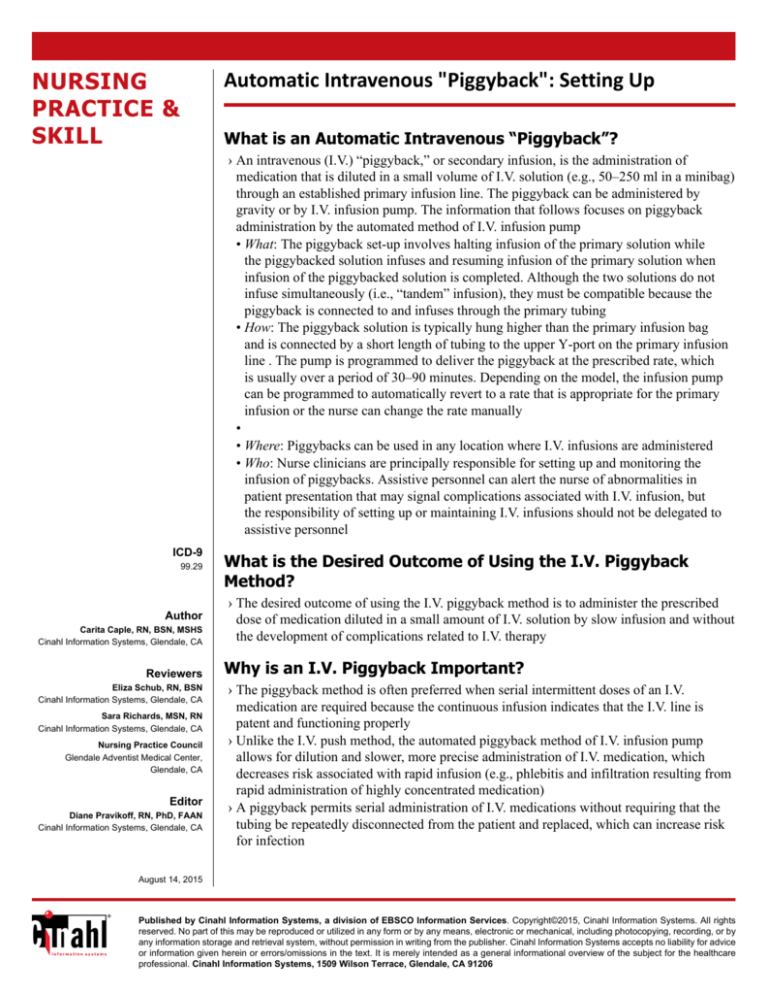
NURSING
PRACTICE &
SKILL
Automatic Intravenous "Piggyback": Setting Up
What is an Automatic Intravenous “Piggyback”?
› An intravenous (I.V.) “piggyback,” or secondary infusion, is the administration of
medication that is diluted in a small volume of I.V. solution (e.g., 50–250 ml in a minibag)
through an established primary infusion line. The piggyback can be administered by
gravity or by I.V. infusion pump. The information that follows focuses on piggyback
administration by the automated method of I.V. infusion pump
• What: The piggyback set-up involves halting infusion of the primary solution while
the piggybacked solution infuses and resuming infusion of the primary solution when
infusion of the piggybacked solution is completed. Although the two solutions do not
infuse simultaneously (i.e., “tandem” infusion), they must be compatible because the
piggyback is connected to and infuses through the primary tubing
• How: The piggyback solution is typically hung higher than the primary infusion bag
and is connected by a short length of tubing to the upper Y-port on the primary infusion
line . The pump is programmed to deliver the piggyback at the prescribed rate, which
is usually over a period of 30–90 minutes. Depending on the model, the infusion pump
can be programmed to automatically revert to a rate that is appropriate for the primary
infusion or the nurse can change the rate manually
•
• Where: Piggybacks can be used in any location where I.V. infusions are administered
• Who: Nurse clinicians are principally responsible for setting up and monitoring the
infusion of piggybacks. Assistive personnel can alert the nurse of abnormalities in
patient presentation that may signal complications associated with I.V. infusion, but
the responsibility of setting up or maintaining I.V. infusions should not be delegated to
assistive personnel
ICD-9
99.29
Author
Carita Caple, RN, BSN, MSHS
Cinahl Information Systems, Glendale, CA
Reviewers
Eliza Schub, RN, BSN
Cinahl Information Systems, Glendale, CA
Sara Richards, MSN, RN
Cinahl Information Systems, Glendale, CA
Nursing Practice Council
Glendale Adventist Medical Center,
Glendale, CA
Editor
Diane Pravikoff, RN, PhD, FAAN
Cinahl Information Systems, Glendale, CA
What is the Desired Outcome of Using the I.V. Piggyback
Method?
› The desired outcome of using the I.V. piggyback method is to administer the prescribed
dose of medication diluted in a small amount of I.V. solution by slow infusion and without
the development of complications related to I.V. therapy
Why is an I.V. Piggyback Important?
› The piggyback method is often preferred when serial intermittent doses of an I.V.
medication are required because the continuous infusion indicates that the I.V. line is
patent and functioning properly
› Unlike the I.V. push method, the automated piggyback method of I.V. infusion pump
allows for dilution and slower, more precise administration of I.V. medication, which
decreases risk associated with rapid infusion (e.g., phlebitis and infiltration resulting from
rapid administration of highly concentrated medication)
› A piggyback permits serial administration of I.V. medications without requiring that the
tubing be repeatedly disconnected from the patient and replaced, which can increase risk
for infection
August 14, 2015
Published by Cinahl Information Systems, a division of EBSCO Information Services. Copyright©2015, Cinahl Information Systems. All rights
reserved. No part of this may be reproduced or utilized in any form or by any means, electronic or mechanical, including photocopying, recording, or by
any information storage and retrieval system, without permission in writing from the publisher. Cinahl Information Systems accepts no liability for advice
or information given herein or errors/omissions in the text. It is merely intended as a general informational overview of the subject for the healthcare
professional. Cinahl Information Systems, 1509 Wilson Terrace, Glendale, CA 91206
Facts and Figures
› Risk for needlesticks and cotransmission of hepatitis B, HIV, and other blood-borne pathogens is 6 times higher when
performing piggyback procedures and intermittent I.V. medication administration than when delivering medication by
I.V. push. The use of needle-free adaptors significant lowers the risk for patient and reduces staff injury resulting from
needlesticks (FDA Safety Alert, 1992)
› Cochrane investigators who compared intermittent antibiotic infusions with continuous or extended (e.g., over a period of
3–24 hours) antibiotic infusions found no difference in patient mortality, clinical cure, infection status after treatment, and
safety between the two methods. The researchers were unable to recommend continuous or extended antibiotic infusion
because there was no added benefit over standard, intermittent antibiotic administration (Shiu et al., 2013)
What You Need to Know Before Setting Up an I.V. Piggyback
› The term “piggyback” is used because the piggyback is hung higher than the primary infusion bag and the I.V. solution is
delivered by gravity, which allows it to be infused while infusion of the primary solution is temporarily halted
• When a piggyback using an automatic infusion pump, it may or may not be necessary to hang the piggyback higher than
the primary infusion bag. “Smart pumps” are pumps that are programmed to actively deliver the piggyback as a secondary
infusion, and then automatically revert to the primary solution and rate, regardless of the height of the solution. When using
a pump that will deliver at only a single programmed rate, the piggyback must be hung higher than the primary infusion to
allow the piggyback to infuse by gravity. To avoid confusion, hanging the piggyback medication higher than the primary
infusion bag can be performed regardless of the pump used
› The term “piggyback” is sometimes used to describe infusion of a small bag of I.V. solution that has been directly connected
to an intermittent access device (e.g., saline lock). However, this set-up is more appropriately described as an intermittent
primary infusion instead of a piggyback
› The clinician should demonstrate competence in adherence to facility infection control protocols and standard precautions,
I.V. assessment, primary infusion set-up and use of an infusion pump, and I.V. medication administration
• When administering medications by piggyback, adherence to the six “rights” of medication administration is important.
These include verifying the right patient, the right drug, the right dose, the right time, the right route, and the right
documentation
• To provide safe medication administration, the nurse must verify compatibility between the medication and diluent
contained in the piggyback and between the piggyback and primary solution
–Piggybacks contain medication that is mixed in a small amount of diluent (e.g., 50–250 ml of 0.9% sodium chloride
or dextrose 5% in water). Depending on facility protocol, the piggyback may be mixed and prepared by a licensed
pharmacist or by the nurse clinician. The nurse should refer to the pharmacy department and/or a drug information
resource for assistance in selecting the appropriate type and volume of diluent if responsible for mixing and preparing a
piggyback
–The piggyback and primary solutions do not infuse simultaneously, but must be compatible because the piggyback
is connected to and infuses in the primary tubing. For the piggyback and primary infusion to be compatible, both the
medications/additives and diluents of both solutions must be compatible
› Familiarity with equipment that is used to administer I.V. solutions and medications is required
• The primary infusion tubing is equipped with a check valve that allows the primary infusion to restart when infusion of the
piggyback is complete. Additional functions of the check valve include
•
–preventing air from entering the system after the piggyback has infused
–preventing the piggyback from “running dry”
–disallowing significant mixing of the primary and piggyback solutions
› Familiarity with potential complications of I.V. medication administration is important. These include
• phlebitis (i.e., venous inflammation), which is characterized by swelling of the vein and redness and warmth of the
overlying skin
•
• infiltration (i.e., leaking of fluid outside of the vein and in the surrounding tissue), which is characterized by blanching and
coolness of the skin, edema, and pain
•
• allergy, which is characterized by itching, swelling, rash, and/or hives
› Errors that can occur during piggyback infusion include over-infusion or under-infusion of medication, incorrect tubing
setup, and errors in programming the infusion pump. Carefully review and practice the procedure for piggyback set-up, and
operation of the designated infusion pump prior to piggyback administration
› Preliminary steps that should be performed prior to setting up an I.V. piggyback include the
› e following:
• Review facility protocol for I.V. medication administration
• Review the patient’s medical record for
–information on allergies (e.g., to latex, medications, or other substances); use alternative materials, as appropriate
–current medications
–the treating clinician’s order for the I.V. medication to be administered
› Gather the necessary supplies, which typically include the following:
• Personal protective equipment (PPE; e.g., nonsterile gloves; use additional PPE [e.g., gown, mask, eye protection] if
exposure to body fluids is anticipated)
• Primary I.V. infusion set
• Secondary I.V. infusion set, which usually includes an extension hook
• Primary solution
• Compatible piggyback (secondary) medication
• Alcohol swabs
• Needle-free adapter, which is strongly recommended instead of a hypodermic needle
• I.V. infusion pump
• Written information, if available, to reinforce verbal education
How to Set Up an I.V. Piggyback
› Perform hand hygiene
› Don PPE as appropriate to avoid transfer of microorganisms
› Identify the patient using facility protocol
› Close the door to the patient’s room and/or draw the curtain around the bed to provide privacy
› Introduce yourself to the patient and family members, if present, and explain your clinical role in the provision of I.V.
therapy
• Evaluate whether the patient/family requires special considerations regarding communication (e.g., due to illiteracy,
language barriers, or deafness); make arrangements to meet these needs, if present
• Assess for knowledge deficits and anxiety regarding I.V. therapy; provide emotional support and additional information as
needed about the purpose of I.V. therapy and related procedures (e.g., routine flushing of the I.V. cannula)
› Plug in and power on the infusion pump
›
› If not previously done, establish the primary infusion as follows:
• Adhering to infection control protocols, hang the primary infusion and spike the port using the primary I.V. infusion tubing
• Prime the primary infusion tubing and thread the tubing through the infusion pump
• Using an alcohol swab, clean the I.V. port or saline lock hub
• Connect the tubing to the I.V. port or saline lock
• Program the pump according to the manufacturer instructions to deliver the infusion at the prescribed rate
• Monitor the I.V. site for complications (e.g., discomfort, swelling)
› Set up the piggyback as follows:
›
• Review the rights of medication administration to verify administration of the correct medication
• Verify compatibility of the primary solution and piggyback
• Use an alcohol swab to clean the upper Y-port on the primary infusion tubing
• Spike the piggyback with the secondary I.V. infusion tubing
• Remove the cap from the secondary tubing and connect the secondary tubing to the upper Y-port on the primary tubing
using a needle-freeadapter
–The secondary tubing should be connected to the primary tubing above the level of the infusion pump
• Prime the secondary tubing by one of the following methods:
•
–Carefully adjust the regulator flow clamp to allow the piggyback medication to fill the tubing, being careful to avoid the
loss of any medication
–Lower the piggyback, open the clamp, and allow the primary solution to prime the secondary tubing
–Program the infusion pump to “backprime” the secondary tubing
• Hang the piggyback higher than the primary infusion bag by connecting an extension hook to the primary bag
• Open the roller clamp on the primary tubing
• Program the infusion pump according to the manufacturer instructions
–If the infusion pump is capable of permitting rate changes between the primary solution and piggyback, program the rate
and volume required to deliver each solution as prescribed. The pump will automatically infuse the piggyback solution
first and then switch to the primary solution and rate. Although it may not be necessary to make changes to the settings,
the nurse clinician must verify that the pump has properly resumed infusion of the primary solution at the correct rate
–If the infusion pump is only capable of a single infusion rate, program it to deliver the piggyback at the prescribed rate
and volume and verify that the piggyback is hung higher than the primary infusion bag so that the piggyback will infuse
by gravity. When the piggyback infusion is completed and the solution in the secondary tubing has fallen below the level
of the primary infusion drip chamber, the primary tubing check valve will open and the primary infusion will begin to
infuse. At this point, the nurse must readjust the infusion rate to that which is prescribed for the primary solution
› Monitor the patient to verify correct administration of the piggyback and primary solutions and to identify the development
of I.V. complications
• Following infusion of the piggyback, leave the piggyback set-up in place for future drug administration or discard it
according to facility protocol
› Discard used materials and PPE, and perform hand hygiene
› Update the patient’s plan of care if appropriate, and document the following information in the patient’s medical record:
• Date and time the primary infusion was established
• Date and time the piggyback was set up and the infusion initiated
• Medication infused via the piggyback, including dose, type and volume of diluent, and rate of infusion
• Patient’s tolerance of the infusion
• Any complications that developed, interventions performed, whether or not the treating clinician was notified, and patient
outcome
• All patient/family education provided
Other Tests, Treatments, or Procedures That May be Necessary Before or After
Piggyback Set-Up
› Continually monitor the I.V. site, patient response to I.V. therapies, and patient safety
• Continued monitoring of the infusion is important in order to quickly identify and resolve problems (e.g., air in the line,
incorrect infusion rate) and manage adverse effects (e.g., allergy, infiltration)
› Most facilities require that a new piggyback set-up be established for each I.V. medication administered, and that the
piggyback infusion bag and tubing should be changed at predetermined intervals. The Infusion Nurses Society Standards of
Practice 2011 recommend changing primary and secondary continuous administration sets “no more frequently than every
96 hours” (Infusion Nurses Society, p. S55)
• Piggyback infusion tubing is considered a primary intermittent I.V. set when disconnected from the primary I.V. tubing
and should be changed according to facility protocol (e.g., every 24 hours) for this type of tubing (Lippincott’s Nursing
Procedures and Skills, 2012)
What to Expect After Setting Up an I.V. Piggyback
› The piggyback will be set up proficiently and the medication will be infused at the prescribed rate
› The medication infusion will be monitored continually and according to facility protocol
› Complications and adverse effects will be promptly recognized and treated according to facility protocol and/or the treating
clinician’s orders
Red Flags
› The clinician must be sure to check the primary infusion rate following medication administration by piggyback
› Immediately stop the infusion if allergic reaction, phlebitis, or infiltration occurs and administer treatment according to the
treating clinician’s orders
› Due to the risk of contamination, a piggyback set up should not be placed on a total parenteral nutrition line
What Do I Need to Tell the Patient/Patient’s Family?
› Explain the purpose of I.V. therapy and the steps involved in medication administration. Verify patient understanding and
provide additional information if necessary
› Immediately respond to patient complaints of discomfort or other signs and symptoms that occur during administration of
I.V. medications, and administer treatment or comfort measures (e.g., a cool compress), as prescribed
References
1. Garrelts, J. C., Smith, D. F., Ast, D., & Peterie, J. D. (1992). A comparison of the safety, timing and cost-effectiveness of administering antibiotics by intravenous bolus (push)
versus intravenous piggyback (slow infusion) in surgical prophylaxis. PharmacoEconomics, 1(2), 116-123. doi:10.2165/00019053-199201020-00008
2. Hadaway, L. (2007). Intermittent intravenous administration sets: Survey of current practices. Journal of Association for Vascular Access, 12(3), 143-147.
doi:10.2309/java.12-3-10
3. Hamilton, S. (2014). Intravenous therapy. In S. M. Nettina (Ed.), Lippincott manual of nursing practice (10th ed., pp. 82-101). Philadelphia: Wolters Kluwer Health/Lippincott
Williams & Wilkins.
4. Infusion Nurses Society. (2011). Standards of practice. Journal of Infusion Nursing, 34(1S), S6-S96.
5. IV secondary line drug infusion. (2014). Lippincott's Nursing Procedures and Skills. Retrieved October 2, 2014, from http://procedures.lww.com/lnp/view.do?pId=792312&s=p
6. Nunnally, M. E., & Bitan, Y. (2006). Time to get off this pig's back?: The human factors aspects of the mismatch between device and real-world knowledge in the health care
environment. Journal of Patient Safety, 2(3), 124-131. doi:10.1097/01.jps.0000233827.90690.97
7. Ostendorf, W. (2014). Parenteral medications. In A. G. Perry, W. Ostendorf, & P. A. Potter (Eds.), Clinical nursing skills & techniques (8th ed., pp. 574-579). St. Louis, MO:
Mosby Elsevier.
8. Shiu, J. R., Wang, E., Tejani, A. M., & Wasdell, M. (2013). Continuous versus intermittent infusions of antibiotics for the treatment of severe acute infections. Cochrane
Database of Systematic Reviews, (3), CD008481. doi:10.1002/14651858.CD008481.pub2


